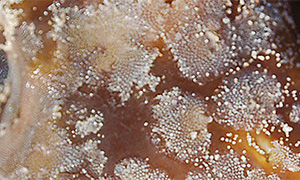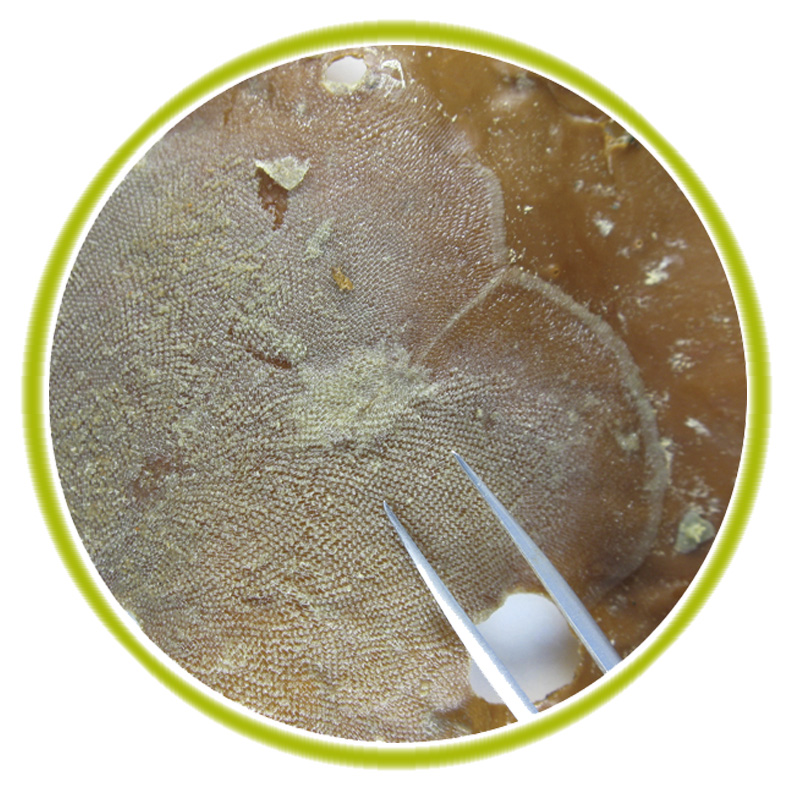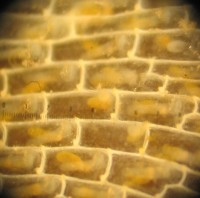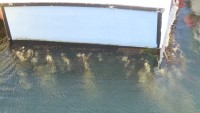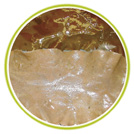Coffin Box Bryozoan
Membranipora membranacea
Report it
If you think you have found an aquatic invasive species:
- do not return the species to the water
- take photos
- note:
- the exact location (GPS coordinates)
- the observation date
- identifying features
- contact us to report it
On this page
- Origin and distribution
- Identifying features
- Habitat
- Ecological and economic impacts
- Mode of arrival
- Mode of dissemination
- Government action
- Coffin Box Bryozoan in Newfoundland and Labrador Waters
- For further information
- References
The Coffin Box Bryozoan is a type of tiny invertebrate animal. Although each individual animal is tiny, they live together with others in large colonies. The Coffin Box Bryozoan feeds by filtering sea water through a ring of tentacles surrounding its mouth, called a lophophore.
Origin and distribution
Native to Europe, the Coffin Box Bryozoan was first found in Canada in Nova Scotia in the early 1990's. It was subsequently discovered in Newfoundland and Labrador in 2002 and in the Gulf of St. Lawrence, Quebec, in 2003. It is now established throughout eastern Canada in:
- Quebec
- New Brunswick
- Nova Scotia
- Prince Edward Island
- Newfoundland
- southern Labrador

Observed distribution of Coffin Box Bryozoan in subregions of Canada's Maritime provinces.
Note: Observation within a subregion does not mean the species is found throughout it. Lack of observation within a subregion does not mean the species is absent from that subregion. It means that it has not been observed there.
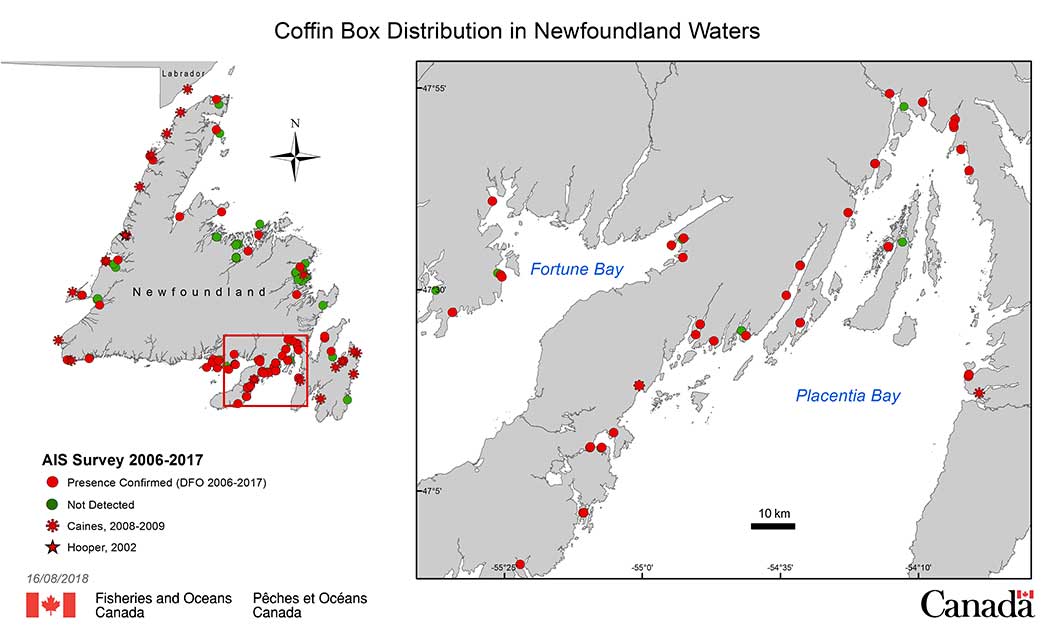
Coffin Box Distribution in Newfoundland Waters
Click image to enlarge.
Distribution Location and Bay
- Argentia: Placentia Bay
- Arnolds Cove: Placentia Bay
- Bar Haven: Placentia Bay
- Bay Bulls: Eastern Avalon
- Bay East: Placentia Bay
- Belleoram: Fortune Bay
- Bird Cove: Northern Peninsula West
- Bonne Bay: West Coast
- Boxey: Fortune Bay
- Burin: Placentia Bay
- Burtons Cove: Fortune Bay
- Cape Broyle: Eastern Avalon
- Codroy: Southwest Coast
- Come by Chance: Placentia Bay
- Coxs Cove: West Coast
- Daniel's Harbour: Northern Peninsula West
- Darbys Harbour: Placentia Bay
- Davis Cove: Placentia Bay
- Eastport: Bonavista Bay
- Foxtrap: Conception Bay
- Gaultois: Hermitage Bay
- Grand Bay West: Southwest Coast
- Grandois: Northern Peninsula East
- Green Island Cove: Northern Peninsula West
- Harbour Breton: Fortune Bay
- Harbour Grace: Conception Bay
- Harbour Mille: Fortune Bay
- Hearts Content: Trinity Bay
- Hermitage: Hermitage Bay
- Holyrood: Conception Bay
- Jean de Gaunt: Placentia Bay
- Lark Harbour: Bay of Islands
- Lewisporte: Notre Dame Bay
- Little Bay: Placentia Bay
- Little Bay East: East Fortune Bay
- Little St Lawrence: Placentia Bay
- Logy Bay: Eastern Avalon
- Long Pond: Conception Bay
- Marystown: Placentia Bay
- Norris Point: Bonne Bay
- North Harbour: Placentia Bay
- Paradise Sound: Placentia Bay
- Petite Forte: Placentia Bay
- Piccadilly: Port au Port Bay
- Placentia: Placentia Bay
- Pools Cove: Fortune Bay
- Port au Choix: Northern Peninsula West
- Port aux Basques: Southwest Coast
- Port aux Choix
- Port Saunders: Northern Peninsula West
- Powell Cove: Bonavista Bay
- Presque Harbour: Placentia Bay
- Raleigh: Pistolet Bay
- Red Bay: Labrador Coast
- Red Harbour: Placentia Bay
- Riverhead: St. Marys Bay
- Rose Blanche: Southwest Coast
- Round Harbour: Notre Dame Bay
- Salamander Point: Fortune Bay
- Salmonier Cove: Connaigre Bay
- Seal Cove: Connaigre Bay
- Southern Harbour: Placentia Bay
- Spanish Room: Placentia Bay
- St. Georges: St Georges Bay
- St. Josephs: Placentia Bay
- Summerford: Notre Dame Bay
- Swift Current: Placentia Bay
- Terra Nova: Bonavista Bay
- Three Rock Cove: Port au Port Peninsula
- Torbay: Eastern Avalon
- Vitters Cove: Trinity Bay
- Westport: White Bay
Identifying features
- Tiny filter-feeding animals that form colonies with a rough texture
- Colour: white
- Colonies are rounded and can reach over 10 centimetres in width
- Individuals within colonies are roughly rectangular (coffin-shaped, hence the name “coffin box”), and very small, each about 0.4 x 0.1 millimetres
Similar species (native)
Hairy Sea-Mat (Electra pilosa)
Coffin Box Bryozoan can be mistaken for the Hairy Sea-Mat, a native bryozoan. It also forms white sheets on seaweed, but it can be distinguished from the coffin box by its star-shaped colonies, hairy extensions and small oval-shaped individuals.
Habitat
This species can be found in shallow subtidal waters from the surface down to a depth of 10 meters, on:
- kelp and other seaweed
- rocks
- boat hulls
- other surfaces and organisms
Grows best in areas with strong currents or good tidal water exchanges.
Ecological and economic impacts
Kelp beds are important because they are highly productive marine habitats. They are a source of food for many animals, as well as a hiding place for many species of fish and invertebrates.
In the fall, colonies of Coffin Box Bryozoan can entirely cover a blade of kelp, causing it to become weak and eventually killing it. The presence of Coffin Box Bryozoan on kelp can starve kelp by preventing it from absorbing nutrients. Coffin Box Bryozoan can reduce the amount of light available for photosynthesis, which may affect growth rates. It disturbs kelp ecosystems, and promotes establishment of invasive plants, such as Oyster Thief. It can also reduce the kelp's ability to reproduce by preventing the release of spores. Overall, these effects can decrease the abundance of kelp, so the spread of Coffin Box Bryozoan in eastern Canada may permanently alter our kelp beds and affect biodiversity along our coasts.
Mode of arrival
Coffin Box Bryozoan was likely introduced to North America in the ballast water of ships arriving from Europe.
Mode of dissemination
Coffin Box Bryozoan has a relatively continuous distribution in Nova Scotia, indicating that its spread is mostly from larval dispersal. Larval abundance varies temporally and spatially and is influenced by water column stratification, with larvae occurring in higher abundances in the higher, shallower, fresher layer above the pycnocline (i.e. the layer of water that separates the warmer, less dense surface from cooler, denser, deep ocean).
Coffin Box Bryozoan can be picked up easily in ballast water because of its dispersive larval phase. It is also known to raft on dislodged kelp and has been found encrusted on drift plastic. This species can successfully invade new areas dues to its short reproductive cycle, fast growth rates, and absence of predators and competitors.
Government action
Fisheries and Oceans Canada is monitoring the distribution of invasive biofouling species (that is, aquatic species that live attached to hard surfaces) on the Atlantic Coast to detect new invasions and track the spread of Coffin Box Bryozoan.
Coffin Box Bryozoan in Newfoundland and Labrador Waters
Discovery and survey findings
From June to November 2008, a survey for Coffin Box Bryozoan was conducted along the west coast of Newfoundland and the southeast coast of Labrador. This survey was a partnership between:
- Memorial University of Newfoundland
- Fisheries and Oceans Canada
- Institute for Biodiversity
- Ecosystem Science and Sustainability
- department of Fisheries and Aquaculture
- Fish, Food and Allied Workers Union
The largest populations of Coffin Box Bryozoan were found in the Bay of Islands and Bonne Bay. North of these locations, the amount of Coffin Box Bryozoan on kelp decreased, with the smallest populations observed along the Strait of Belle Isle. During the entire survey, the greatest number of colonies of Coffin Box Bryozoan on kelp was observed in the fall of 2008.
In September and October of 2009, another survey found many colonies of Coffin Box Bryozoan on kelp at North Harbour and Arnold's Cove and a few individual colonies at Eastport, Red Harbour, Holyrood and Bay Bulls.
Controlling abundance
Coffin Box Bryozoan can spread over large distances by releasing larvae, which are carried by ocean currents. They can also be spread through human activity. Coffin Box Bryozoan has been observed on boat hulls, growing on the kelp that is attached to the hull. To help control the spread of this aquatic invasive species, regularly clean and disinfect boats and boating gear.
For further information
- Canadian Science Advisory Secretariat (CSAS) Publications
- Biological synopsis of the lacy crust bryzoan (Membranipora membranacea)
Feature article, DFO Science, 2012 – Fisheries and Oceans Canada - Aquatic Invasive Species: Coffin Box in Newfoundland and Labrador Waters
Fisheries and Oceans Canada - 2011
References
- Burridge, M. 2012. Biological synopsis of the Lacy Crust bryozoan (Membranipora membranacea). Can. MS Rpt. Fish. Aquat. Sci. 3006: iii + 25p.
- Caines, S. and P. Gagnon. 2010. Population dynamics of the invasive bryozoan Membranipora membranacea along subarctic and temperate longitudinal and latitudinal gradients. Newfoundland and Labrador Aquatic Invasive Species Workshop. St. John's, NL.
- Chapman, A. S., R. E. Scheibling, and A. R. O. Chapman. 2002. Species introductions and changes in the marine vegetation of Atlantic Canada. Pages 133–148 in R.Claudi, P. Nantel, and E. Muckle-Jeffs, eds. Alien invaders in Canada's waters, wetlands, and forests. Natural Resources Canada, Canadian Forest Service, Ottawa.
- Date modified:
